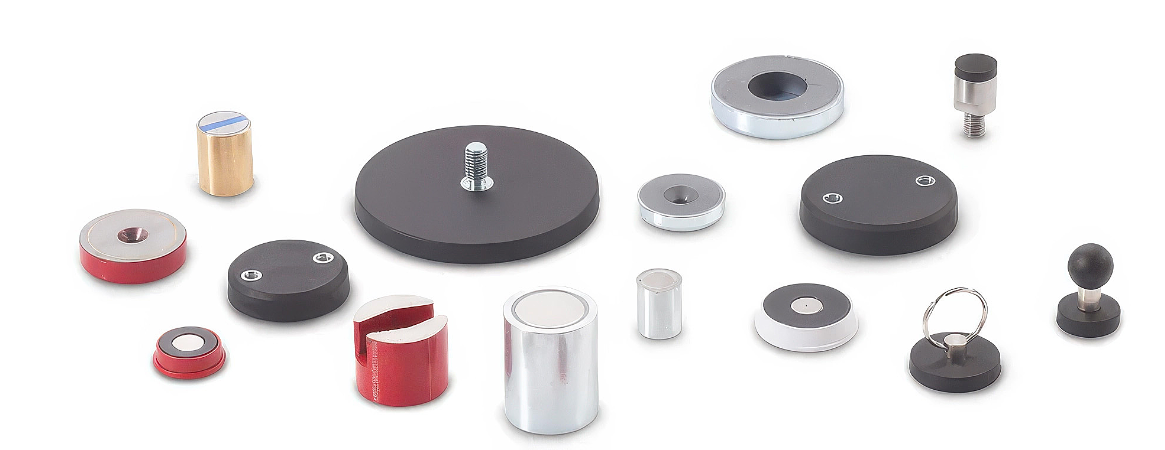Designs and structure
Designs
There are seven different magnet types based on a conceptual classification with respect to the shape and function:
Button-type magnets and U-magnets as well as retaining magnets that are disc-shaped or rod-shaped form the largest group along with screws with retaining magnet. The name retaining magnet bears such elements that are used for direct fastening. Raw magnets generally help to structure application-specific magnetic systems.
Structure
Apart from button-type magnets/U-magnets and raw magnets, magnetic systems can also be used. Due to their structure, they have only one magnetic contact surface. Through magnetic return plates, the entire magnetic energy is concentrated on the attracting surface and the spatial effect of the magnetic field is restricted in order to prevent any magnetization of the environment.
Materials of the magnet
Within various designs, various materials of the magnet are available to choose from. In order to meet application-specific conditions in as far as possible, the most important characteristics of the respective materials of the magnet are given in the following table.
Comparison of magnet materials
| Designation | Hard ferrite (HF) | AlNiCo (AN) | SmCo (SC) | NdFeB (ND) |
| Retaining force | High | Medium | High | Very high |
| Max. usage temperature | ≈ 200 °C | ≈ 450 °C | ≈ 200 °C | ≈ 80 °C |
| Retaining force when warmed | Lower | Unchanged Good | Lower | Lower |
| Corrosion resistance | Very high | Very high | High | Nickel-plated - high |
| Made of | Iron oxide | Aluminum, nickel, cobalt and iron | Samarium and cobalt | Neodymium, iron and boron |
| Manufacturing process | Sintering | Sintering, casting | Sintering | Sintering |
| Mechanical material properties | Very hard, brittle | Very hard, tough | Very hard, brittle | Very hard, brittle |
| Machinability | Not possible | Grinding with diamond possible | Not possible | Not possible |
| Demagnetization capability | Moderate, by demagnetizing fields | Easy, by demagnetizing fields | Very difficult, only by strong demagnetizing fields | DIfficult, only by strong demagnetizing fields |
| Price level | Very inexpensive | High | Very high | Inexpensive |
Handling and safety instructions
The sometimes high magnetic forces of the magnets are a possible source of risk since fingers or skin can be crushed or pinned. Suitable protective measures, such as safety gloves, should therefore be observed in the handling of magnets to prevent injuries. It must also be noted that magnets can attract each other from great distances, depending on their strength, and also pose a risk of injuries in this way.
When magnets collide forcefully, chips can be cracked off the edges or the entire magnet may break in extreme cases. Special raw magnets in an unprocessed condition can be impacted by improper handling.
Magnets must never be installed in environments at risk to explosion since they can trigger sparks.
Strong magnetic fields can influence or damage electrical or electronic devices. This applies to pacemakers, etc. The information from the device manufacturer regarding the specified safety distance must be observed.
Disadvantageous effects of magnetic fields on the human body are not known at this time.

